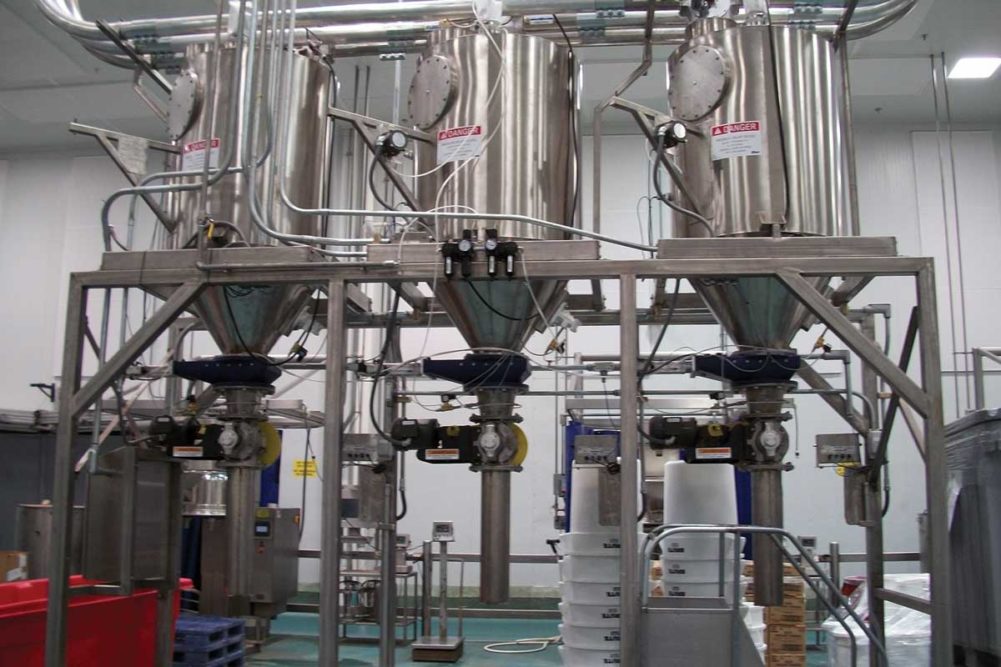When an ingredient handling system is designed to handle minors and micros from the outset, it is possible for bakers to achieve high levels of accurate scaling and efficient delivery. For scaling accuracy, that means choosing the appropriate equipment that will meet the needs of the ingredients being scaled.
The ingredients being used, the ranges of weights for each and the tolerances will all impact system design. Bakers also must consider required batch cycle times and total ingredient usages per shift/day. It’s also important to define exactly what constitutes a minor or micro ingredient. Typically, minor ingredients are those that require a batch draw of more than 50 to 500 lbs.
“It is typical to achieve around a 1% tolerance on minors, which means you are typically looking at a scale and equipment that can read in increments of 0.1, 0.2 or 0.5 lbs,” said Mike Drew, engineering supervisor, Sterling Systems & Controls.
Micro ingredients, requiring a batch draw of less than 50 lbs per batch, demand even tighter accuracy that can only be achieved with precision load cells and strain gauges that can read in 0.01, 0.001 or smaller increments, Mr. Drew explained.
These tiny amounts require specifically designed equipment. Equipment designed to scale and transfer large amounts of flour will not be able to accurately scale a small amount of baking powder.
“Accuracy can be achieved provided the properly sized equipment is used for a given ingredient,” said James Toole, product manager, bulk handling systems, Gemini Bakery Equipment/KB Systems. “The design of the weighing and metering equipment is a critical part of achieving the accuracy required.”
Having the appropriate scale is of the utmost importance when trying to get accurate weighing with such small measurements.
“For this reason, we will select a number of different size scales for a system that are suitable to deliver scaling accuracy for the major, minor and micro ingredients so that all the ingredients are weighed with similar design accuracy, even though the addition levels may differ significantly,” said John Hunter, sales account manager, Bühler Group.
Zeppelin Systems USA’s Tracemat has a weighing precision of 1 gram. This ensures reliability, traceabiliy and an increase in production. When recipes are input into the PLC, tolerances for each ingredient can be set, preventing weights from being outside of the specifications. The Tracemat also introduces traceability into the micro ingredient process.
“Once all the ingredients of the recipe are weighted, a printer prints a code-bar label,” said David Rodriguez, regional sales engineer, South America, Zeppelin Systems USA. “The label contains all necessary data to trace the whole process: ingredients, specific weight, real executed weight, time of recipe composition, name/code of the operator and so on.”
Spiromatic designed its entire system to ensure accuracy from storage to mixing bowl. Storage bins and extraction systems are designed specifically to the ingredient needs. Micro dosing screws or spirals accurately dose ingredients in small weigh hoppers. Once minor ingredients are pre-weighed into batches, they are transported with plug flow vacuum conveying where the batch is conveyed in one plug.
“This avoids the effects that exist with dilute phase conveying where the product is transported suspended in the process air and therefore being less accurate,” said Pieter Van Hoecke, business development manager, North America, Spiromatic.
This article is an excerpt from the October 2020 issue of Baking & Snack. To read the entire feature on ingredient handling, click here.





